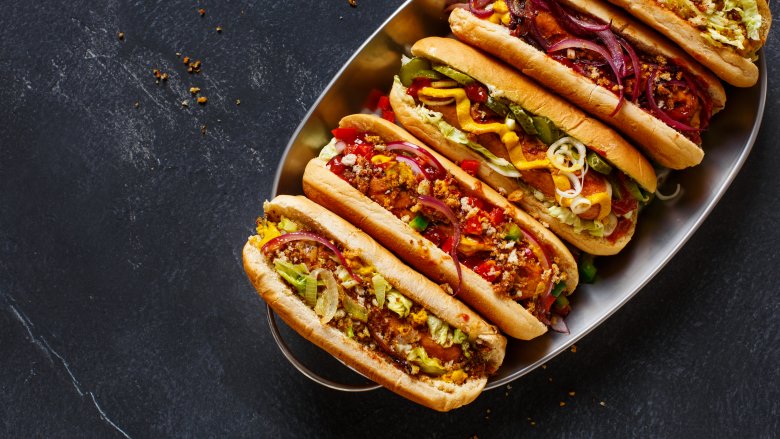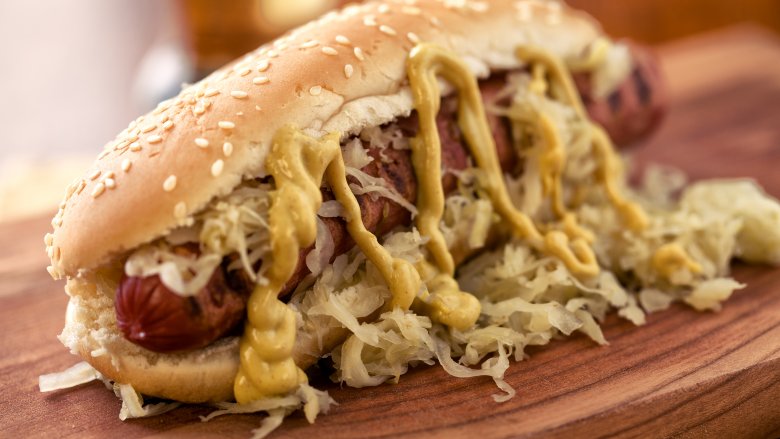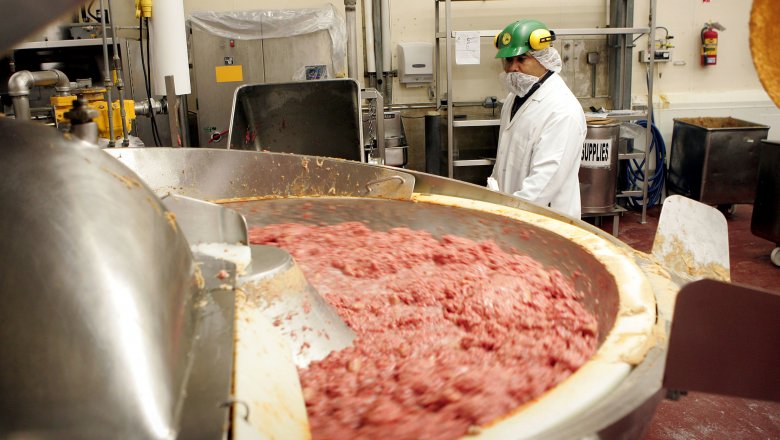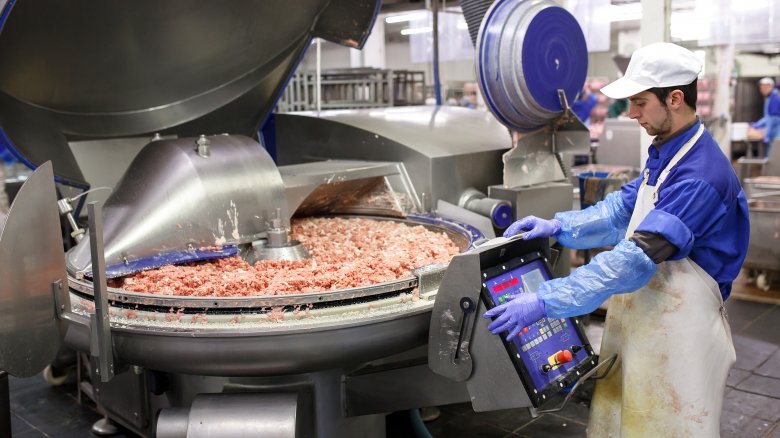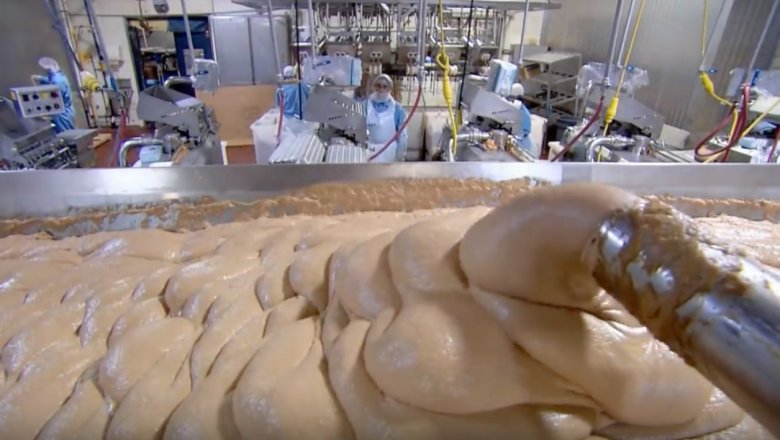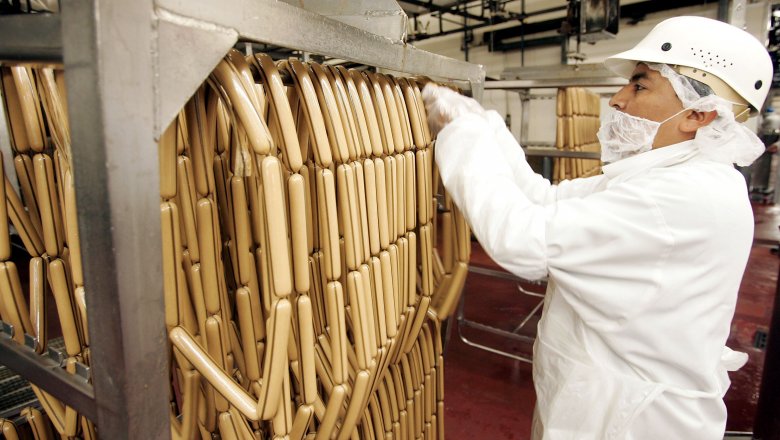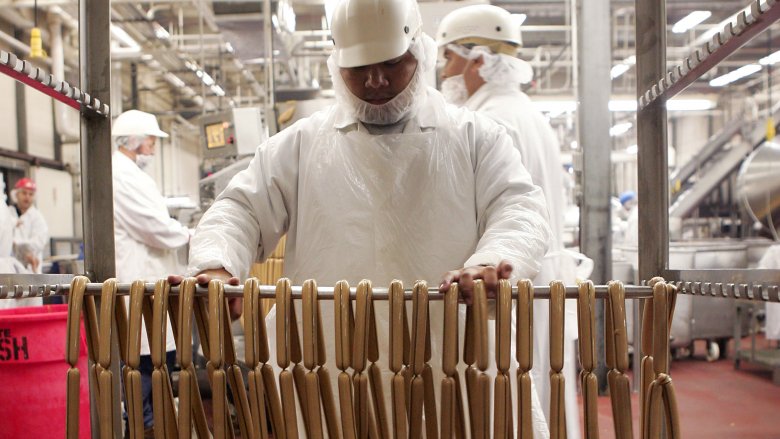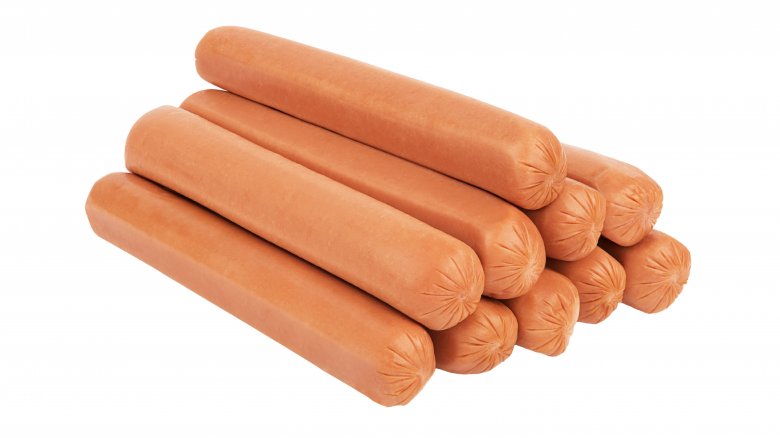This Is How Hot Dogs Are Really Made
You already know how the old saying goes: "If you love hot dogs, you'd better not look too closely at how they're made." The fact is, whether you love your hot dogs fried at home in butter, or steamed in a container of murky water from a pushcart in the big city, whether you take your dogs plain with just a dab of mustard, or piled high with tomato, pickles, neon-green relish, and celery salt, you probably haven't spent a lot of time squinting too closely at that tube of cylindrical cased meat.
Hot dogs have long been a favorite target among hardcore vegans and your woke friends with the more refined palates, who would never think of "poisoning their bodies" with such a heavily processed amalgamation of animal parts. The humble hot dog has taken a lot of heat for its perceived low-quality ingredients, seemingly questionable manufacturing and packaging processes, the lack of nutritional value, and the potential link between the consumption of processed meats and certain serious illnesses, including type 2 diabetes, cardiovascular disease, and some types of cancer.
But for all of the scary headlines, most of us don't fully understand how hot dogs are manufactured. We took a look at the entire process, from start to finish, and were surprised by what we found. Join us, as we take a detailed look at how hot dogs are really made.
We have German immigrants to thank
Many of us take the existence of hot dogs for granted. After all, they've always been there for us, whether as a quick after-school snack or a late-night post-pub crawl bit of "get home" fuel. But where did hot dogs come from in the first place, and how did they become such a popular American dietary staple?
While humans have been making ground up animal meat into sausages for literally thousands of years, the product that we came to think of as the "hot dog" was developed much later. Some credit Frankfurt, Germany with the invention of hot dogs as early as 1484. Other leading hot dog scholars contend that the invention probably occurred in Vienna, Austria. Still others believe that the modern-day hot dog came even later, when Johann Georghehner (who was from Coburg, Germany) produced the "dachshund" sausage in the 1600s.
Whichever version of hot dog history you choose to believe, the product didn't arrive on American shores until the 1850s, when German immigrants Charles Feltman and Antoine Feuchtwanger began selling "dachshund sausages" topped with sauerkraut from a pushcart in Coney Island, New York. The product caught on at baseball parks, and Americans quickly developed a new national pastime: Eating hot dogs.
Traditional hot dogs start with trimmings
Ah, trimmings. It's a vague word designed to hide all manner of sins, isn't it? Early in human meat-eating evolutionary history, someone noticed that after carving all of the ribs, steaks, chops, hams, legs, and cheeks out of an animal, there was a pile of unappealing stuff leftover that really shouldn't go to waste. And it's this desire to use every part of the animal, which led to the invention of sausage, and eventually hot dogs.
Whether you choose beef, chicken, or pork hot dogs, chances are they're made up of a bunch of different animal parts that most wouldn't consider "prime cuts." The Food and Agriculture Organization of the United Nations (FAO) defines those as: "The raw meat materials used for precooked-cooked products are lower-grade muscle trimmings, fatty tissues, head meat, animal feet, animal skin, blood, liver and other edible slaughter by-products."
Sure, the term "slaughter by-products" may not exactly whet your appetite, but making hot dogs means making sure that no parts of the animals we raise and systematically kill go to waste, and that's a concept that most of us can get behind.
The trimmings go through a grinder
Before the real down-and-dirty business of hot dog manufacturing can begin, all of those unsavory trimmings have to be ground down into a more manageable, uniform product. Most often, the types of meat used in hot dogs are some combination of pork, beef, chicken, or turkey.
In the Unites States, hot dogs that contain sketchier cuts of meat must be labeled as containing "Byproducts" (organ meats) or "Variety Meats" (raw skeletal muscle). Those containing byproducts must be listed and called out by species on the ingredient panel. So-called "mechanically separated meat," whereby pork bone (but never cow bone; thanks, Mad Cow Disease) is pushed at high pressure through a sieve to scrape every last remaining scrap of usable meat off the carcass is permitted, but this kind of meat cannot make up more that 20 percent of the contents of the finished product.
The trimmings, along with assorted by products and variety meats, are loaded into giant meat grinders, similar to the ones you've seen the butcher using to grind hamburger at the grocery store. All of those different animal parts are finely ground at this stage, to form a sort of loose, pebbly-textured meat mashup.
Salt, sweeteners, and spices are added
After the all the components are ground together, with the resulting product looking more like usable meat and less like a disparate pile of scrapped animal garbage, it's time to start adding the flavor and texture ingredients that help differentiate one hot dog brand from the next.
Regulations dictate that finished hot dogs can contain up to 30 percent fat, and up to 10 percent added water. A full 3.5 percent of a hot dog can be made up of "non-meat binders and extenders," which can include dry milk or cereal. An additional 2 percent can be isolated soy protein, and all of these "extra" ingredients must be designated on the label.
The meat mixture might receive a heavy dose of salt (sodium phosphate, which keeps things moist), and additional preservatives and seasonings, which may include artificial and natural flavors, spices, corn syrup, or additional water. The exact recipes and proportions of ingredients vary from manufacturer to manufacturer, which is why all hot dogs tend to taste a little bit different from one another.
The mixture is pureed and air is removed
After the ground hot dog mixture has been appropriately seasoned and had all the preservatives and bacteria-inhibiting agents added, it's time for the really gross part. For many, this is the stage of the hot dog-making process that is accompanied by visuals that will haunt your dreams.
The entire mixture is blended with water until it is smooth, resulting in a pale pink meat mixture that's roughly the color and consistency of bad buffet restaurant soft serve ice cream. And since nature abhors a too-dry wiener, additional water is added to get the consistency of the slurry just right.
The meat mixture is typically pureed again at this stage, and the excess air in the raw hot dog batter is vacuumed out of the meat in order to make the finished hot dog more dense and have a firmer texture. From there, it's on to the casing machines, to give the hot dogs their familiar shape that's perfect for buns.
The puree is pumped into cellulose casings
While natural-cased hot dogs (which are typically made from the cleaned intestines of sheep or lamb) are growing in popularity, thanks in part to their characteristic snap, the biggest retail hot dog brands in the United States tend to be skinless. But whether they end up on supermarket shelves in a casing or not, casing the meat puree is still a big step in the manufacturing process; it's what gives hot dogs their signature shape.
After all of that pink meat batter passes inspection, it is pumped into an automatic stuffing and linking machine. The meat is blasted at high pressure into tube-shaped, cellulose casings (made from synthetic material), which are then twisted at precise intervals to produce a long string of equally-sized hot dogs. The production rate of these machines is incredibly fast; in fact, it takes just 35 seconds to produce a chain of hot dogs so long it would span the length of a soccer field... twice.
The hot dogs are baked in giant conveyor ovens
After being stuffed into their cellulose casings and twisted into precise lengths (usually about 5 inches), the hot dogs still need to be fully cooked before they can move to the next step in the manufacturing process.
At this point the hot dog strands are loaded onto giant conveyor racks and are first rolled through a shower of liquid smoke before moving into an oven with several cooking zones. Here, they are thoroughly cooked under controlled temperature and humidity conditions, and all that liquid smoke has a chance to permeate the casing for an added boost of flavor while they bake.
After the cooking process is complete, the fresh-from-the-oven hot dogs get one more shower, this time with cold saltwater, which helps to quickly drop their temperature and get them ready for packaging. But first we've got to deal with those inedible cellulose casings...
The casing is removed with a puff of steam
After cooking and cooling, the hot dog links are moved via conveyor to an automatic peeling machine, to strip them of their cellulose casings. Once they hit the peeler, the cellulose casings are sliced open with a tiny knife, and then the hot dogs are blasted with a burst of high-pressure steam, which blows off the casing and leaves just the bare naked hot dog remaining.
This all happens much more quickly than the time it took you to even read that sentence; a typical hot dog peeling machine can process upwards of 700 hot dogs per minute (or about 11-1/2 hot dogs per second), shooting them rapid-fire out the other side of the peeling machine like a firehose that dispenses a heavy stream of whole hot dogs instead of water, which by the way, would be singularly ineffective at keeping a house from burning down, but delicious nonetheless.
The hot dogs are inspected for defects
After being smoked, receiving their cooling spray of life-giving saltwater, and being stripped of their casing, the nearly-finished hot dogs move along a conveyor belt where they receive a final inspection. The hot dogs get a quality control check to ensure they're the proper weight, and only tubed meat that could be considered flawless (which is a term that we use somewhat loosely, now that we know what's inside of them) makes it through these final quality control checks, before being passed off for packaging.
Hot dogs which are damaged, broken, or torn at any point in the process are pulled from the line and prevented from entering the packaging process, ensuring that every package of hot dogs you crack open for a backyard barbecue is consistent, perfect, and ready to hit the grill. Because honestly? If you ever opened a package of hot dogs to find a mutilated, shredded mess, you would never buy that brand again.
The hot dogs are packaged and shipped to stores
Ah, the final step, when hot dogs can begin the last part of their journey from "pile of meat scraps" to finished product, nestled all cozy and delicious in a steamed bun at your backyard barbecue. After the cellulose casings are removed and the finished hot dogs receive a final quality control check, the hot dogs make their way to the packaging machinery. Here, hot dogs are lined up on sheets of plastic film printed with all of the graphics and marketing claptrap commonly found on supermarket dogs. The film is folded over and vacuum-sealed to preserve the hot dogs' flavor and extend their shelf life, and then transported to a stamping machine, which prints a freshness date on each individual package.
After packaging, the finished hot dogs are shuffled off into boxing machines, loaded onto pallets, and shipped in refrigerated trucks to supermarkets, to be loaded into shopping carts and shoved down the gullets of families nationwide. The entire process may seem like a long, complicated journey, but it all happens remarkably quickly; it takes just a few hours to manufacture each batch of hot dogs, from the time the meat first rolls into the factory, to the time the delicious finished product is boxed up and shipped out.
